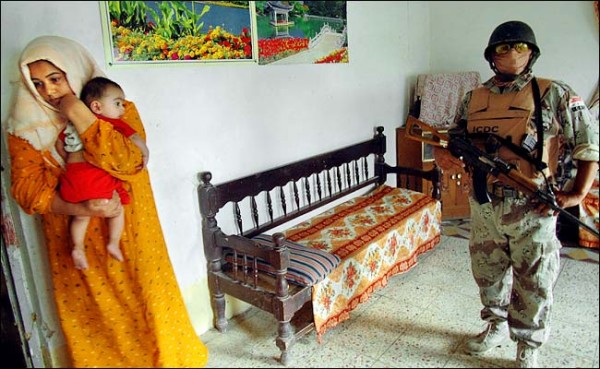Notes
Punching Up The Orange
This Sunday’s latest perfunctory Iraq story in the NYT seems to sum up what’s wildly wrong with the coverage of the war — as well as, perhaps, what’s wrong with the overall American military strategy. Simply put, there is no context to it.
Take this image, for example. The article it accompanies (U.S. Uncovers Vast Hide-Out of Iraqi Rebels — link) describes a large underground rebel hideout discovered by U.S. troops in Karma, west of Baghdad. The photo, however, depicts an Iraqi soldier searching a home in Mahmudiya, south of Baghdad. What one has to do with the other is a complete mystery. (What’s going on in this photo is also hard to discern.)
How can we account for the fact this picture bears no relation to the story? Is it just a routine journalistic circumstance? Could it be a consequence of the difficulty covering a war? Or, could it result from the way the press has been partitioned from fuller access to the hostilities?
(Do you notice, by the way, how little mention is made these days about the policy of embedding journalists and photographers? Over time, the effect has been to confine our correspondents to a stenographic function, narrowing their ability to ask larger questions — either about specific missions or the war over all. And, while on the subject, maybe it’s time to review the term “embedded” itself. “Embedded” sounds so objective, it deflects attention from what it now signifies — which is a form of censorship and media control.)
Another curious thing going on is that we have the image of an Iraqi-led raid paired with a story about an American-led military operation.

Maybe it’s just how goofy this masked Iraqi soldier looks (as he poses for a picture in a role I’m used to seeing American soldiers play much more effectively). Maybe it’s partly the English letters on his vest. Either way, the question it raises for me — especially if you read the authoritative statements of the Marine spokesperson in the article — is just how much this war remains our war, and the ultimate operating power remains in our hands.
There are other visual elements to consider, as well:
It’s always interesting to see how photo cropping can effect a story — especially on the web. In the on-line article, if you didn’t click to enlarge this smaller image, all you would visually know of this story was the shot of this soldier alone.
When I mention this following point, some people take me to task for calling out a standard — if fairly recent — convention used frequently by the NYT. If you’ll notice, this image is super color-saturated. (Just look at how punched up the orange is, or the baby’s clothes.) The effect is to make the image more lush and visually seductive. The net effect is a troubling contradiction between the content and its sensory impact.
Also, if you’ve been following the BAG for a while, you know that I’ve been quite interested in these wartime scenes of domestic intrusion. Why is there such a premium on images featuring male soldiers holding sway in a home with women and children at their mercy? If this situation is so innocuous that this soldier can stand off to the corner and pose for a picture, why is he still there hanging around? (By the way, if a readers could identify these paintings or posters, it would be helpful. The presence of art seems to suggest a more important or well-to-do household, which might be a clue why these soldiers would be inclined to pause and capture the visual souvenir.)
Finally, there are few issues I have specifically with this article:
The Marine spokesman states that this is “the largest underground system discovered in at least the last year.” I thought I was following the war pretty closely, but I wasn’t aware we had found any underground lairs, large or small. From reading this, by the way, I don’t have a sense of how many more underground lairs there are out there, how significant they are, or what importance this discovery has relative to the overall fight. (In fact, in makes me think that this is just one more suddenly discovered facet about the all too invisible enemy that shows we really don’t have a good sense of who or what we are dealing with.)
(image: Alan Chin/The New York Times. June 5, 2005 in The New York Times, p. A13)



Reactions
Comments Powered by Disqus